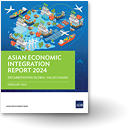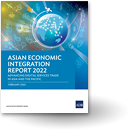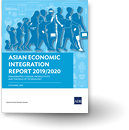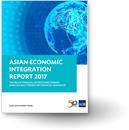
-
- Themes
- Database
- AEIR Data Catalogue
- Free Trade Agreements
- Macroeconomic database:
- Regional Cooperation and Integration database:
- Daily Market Watch
- Resources
- Events
- Economies
- Central Asia
- East Asia
- Oceania
- South Asia
- Southeast Asia
- The Pacific
- COVID-19

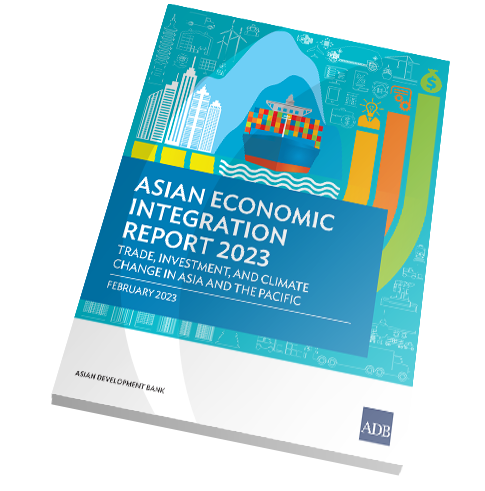
Asian Economic Integration Report 2023
Trade, Investment, and Climate Change in Asia and the Pacific
The Asian Economic Integration Report (AEIR) reviews Asia and the Pacific’s progress on regional cooperation and integration and the states of trade, cross-border investment, financial integration, and the movement of people. According to the 2023 report, integration in the region is progressing steadily and remained stable in 2020 despite the COVID-19 pandemic. This year’s theme chapter, “Trade, Investment, and Climate Change in Asia and the Pacific”, examines how trade and investment, which have been the main driver of the region’s economic growth and industrialization, contribute to climate change, and what policy measures need to be taken to make trade and investment part of climate solutions.
Regional integration is progressing steadily, with Southeast Asia integrating faster than other Asian subregions. Economies covered by the subregional initiatives in Southeast Asia, specifically the Association of Southeast Asian Nations and the Greater Mekong Subregion are relatively more integrated than others.
Asia’s regional trade integration continues to deepen as measured by its intraregional trade share. The region still has great potential to further cultivate deeper value chain linkages in high-tech and services industries by lowering trade barriers and forging closer economic relationships in these areas.
Global FDI recovered in 2021, accelerating by over 60% compared with 2020. While global growth for 2022 may be tempered by external economic pressures, the outlook for Asia and the Pacific remains stable given the region’s consistent reputation as a hub for inward investments.
Increased financial integration in Asia and the Pacific could help recycle a greater portion of regional savings into regional investments. Yet, policy makers in the region need to remain vigilant in monitoring financial market conditions and guarding against spillover effects and financial distress.
International migration continued as more borders reopen and travel requirements ease, helping bolster remittance inflows to Asia and the Pacific which grew 3.4% in 2021. Recovery in international tourism is gaining ground but arrivals remain well below the 2019 level.
Asia and the Pacific is on the frontline of climate change, with high exposure to extreme weather and many people living in low-lying coastal areas. Almost 40% of disasters worldwide have occurred in Asia and the Pacific.
The Asia and Pacific region needs to embrace “climate smart” policies to ensure trade and investment can be part of the climate solutions.
Policy makers can promote trade in environmental goods and services; nurture green businesses; enhance international cooperation on regulations; and develop carbon pricing mechanisms.
Contents:
Download chapter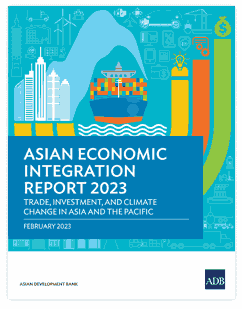
Cover and highlights
Download chapterRegional Cooperation for Transformative Economic Recovery
Download chapter Download Online AnnexTrade and Global Value Chains
- Recent Trends in Asia’s Trade
- Asia’s Intraregional Trade
- Progress of Global and Regional Value Chains
- Special Topic: Food and Energy Crisis and Asia’s Trade
- Asia’s Free Trade Agreement Policy
- Digital Economy Agreements and Policy Interventions
- Trade-related Measures and Temporary Restrictions
Download chapterCross-Border Investment
- Recent Trends in Foreign Direct Investment
- Policy Focus: Investment Tax Incentives in Asia and the Pacific
- Policy Recommendations
Download chapterFinancial Cooperation
- Special Topic: The Issue of Dollar Dependence in Financing and Trade Invoicing
Download chapterMovement of People
- Migration
- Remittances
- Tourism
Download chapterUpdates on Subregional Cooperation Initiatives
- Integration Index Estimates for Subregional Initiatives
- Central Asia Regional Economic Cooperation Program
- Greater Mekong Subregion Program
- Brunei Darussalam–Indonesia–Malaysia–Philippines East ASEAN Growth Area and Indonesia–Malaysia–Thailand Growth Triangle
- Bay of Bengal Initiative for Multi-Sectoral Technical and Economic Cooperation
- South Asia Subregional Economic Cooperation
- South Asian Association for Regional Cooperation
- The Pacific: Regionalism to Support Resilience
- Promoting Climate Change Agenda as a Cross-Cutting Theme
Download chapterTHEME CHAPTER: Trade, Investment, and Climate Change in Asia and the Pacific
- Introduction
- The Trade/Investment and Climate Change Nexus
- Emissions from Production, Demand, and Trade
- Impact of Industrial Structure and Technique
- Foreign Direct Investment Impact on Environmental Outcomes
- Challenges in Greening Trade and Investment
- How Can Trade and Investment Policies Be Integrated with Climate Action?
- Promoting Trade in Environmental Goods and Services
- Nurturing Green Businesses
- Bilateral, Regional, and International Cooperation
- Carbon Pricing Mechanisms
Download chapterStatistical Appendix
- Regional Groupings
- Table Descriptions
- Methodological Note and Update—AEIR Cross-Border Investment Firm-Level Data
AEIR Archives:
ASIA REGIONAL INTEGRATION CENTER© 2015 Asian Development Bank. All rights reserved. Reproduction in whole or in part without permission is prohibited.About usThe Asia Regional Integration Center (ARIC) is an ongoing technical assistance project of the Economic Research and Development Impact Department (ERDI). Following the 1997/98 Asian financial crisis and the contagion evident around the region, ADB was asked to use its knowledge-based expertise to help monitor the recovery and report objectively on potential vulnerabilities and policy solutions. With the ASEAN+3 process just starting, ADB provided technical assistance beginning in 1999—to create the Asia Recovery Information Center, the precursor to ARIC.Contact usPlease help us improve the ARIC website by sending us your comments. These may be on content, (e.g., articles posted on or for which links are provided in the ARIC website), website structure (e.g., do you find ARIC's sections useful?), ease of navigation, or even page design and layout.
Send all your comments to: aric_info[at]adb.orgQuick links
Other ADB sites:
ADB Regional Cooperation and Integration | Asian Bonds Online | Asian Development Bank Institute | RTA Exchange

